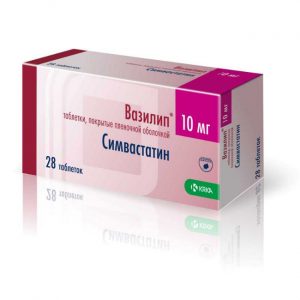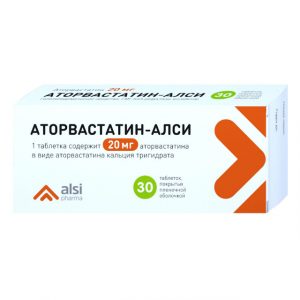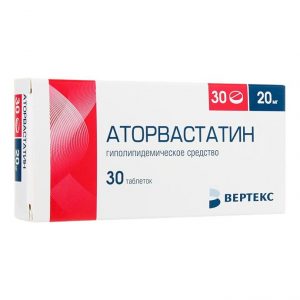Description
film release form
film-coated tablets
packaging 60pcs
Indications
² Ñ Primary hypercholesterolemia (heterozygous familial and non-familial hypercholesterolemia (IIa type according to the Fredrickson classification)
² Ñ Combined (mixed) hyperlipidemia (IIa and IIb types according to the classification Fredriksemonepreneprienoperonemoniporideprioperonemoniporideprioperonemoniporideprioperonemoniporideprioperonemoniporideprienoperonemoniporideprioperonemoniporideprioperonemoniporideprienoperonemoniporideprioperonemoniporideprienoperonemonidepriopleponeprenopyrenoponideprenoperonemoniporideprienoperonemoniporideprienoperonemonideprioperoneprenoprienoperonemonide to diet)
² Ñ Familial endogenous hypertriglyceridemia (type IV according to Fredrickson classification), resistant to
diet ² Ñ Homozygous familial hypercholesterolemia with insufficient diet efficacy therapy and other non-pharmacological methods of treatment
² Ñ Prevention of cardiovascular disease:
– Primary prevention of cardiovascular complications in patients without clinical evidence of coronary heart disease (CHD) but having several risk factors for its development: age older than 55 years, nicotine addiction, arterial hypertension, diabetes mellitus, genetic predisposition, including against the background of
dyslipidemia – Secondary prevention of cardiovascular complications in patients with coronary heart disease in order to reduce the total mortality rate, myocardial infarction, stroke, re-hospitalization for angina pectoris and the need for revascularization.
Contraindications
Hypersensitivity to any component of the drug. Active liver disease or an increase in the activity of liver transaminases in blood plasma of unclear origin more than 3 times in comparison with the upper limit of normal. Age up to 18 years (insufficient clinical data on the effectiveness and safety of the drug in this age group). Lactose intolerance, lactase deficiency, glucose-galactose malabsorption. Hypersensitivity to soy and peanuts. Pregnancy and the period of breastfeeding. Use in women planning a pregnancy and not using reliable methods of contraception.
With caution
Alcohol abuse, a history of liver disease, diseases of the muscular system (history of the use of other members of the HMG-CoA reductase inhibitor group), severe water-electrolyte imbalances, endocrine (hyperthyroidism) and metabolic disorders, severe acute infections ( sepsis), arterial hypotension, diabetes mellitus, uncontrolled epilepsy, extensive surgery, injuries.
Use during pregnancy and lactation
Atorvastatin-SZ is contraindicated in pregnancy. Women of reproductive age should use adequate methods of contraception during treatment. The drug Atorvastatin-SZ can be prescribed to women of reproductive age only if the probability of pregnancy is very low, and the patient is informed about the possible risk of treatment for the fetus. The drug Atorvastatin-SZ is contraindicated during lactation. It is not known whether atorvastatin is excreted in breast milk. If it is necessary to prescribe the drug during lactation, breastfeeding should be stopped to avoid the risk of adverse events in infants.
Composition of
atorvastatin calcium in terms of atorvastatin – 20 mg
excipients (core):
lactose monohydrate (milk sugar) – 124.0 mg calcium carbonate – 66.0 mg povidone K 30 (polyvinylpyrrolidone) average 30 mg croscarmellose sodium (primellose) – 13.5 mg sodium stearyl fumarate – 3.0 mg silicon colloidal dioxide (aerosil) – 1.5 mg microcrystalline cellulose – 60.0 mg excipients (coating): Opadry II (polyvinyl alcohol, partially hydrolyzed – 3.96 mg macrogol (polyethylene glycol) 3350 Talc 1.1115 mg – 1.8 mg of titanium dioxide, E 171 – 1.7253 mg Soy lecithin E 322 – 0,315 mg Aluminum lacquer based dye indigo – 0.0054 mg Aluminum Lake Dye azorubin – 0 0459 mg aluminum dye based crimson dye [Ponceau 4R] – 0.0369 mg).
Dosage and administration
Inside.
Take at any time of the day, regardless of food intake. Before starting treatment with Atorvastatin-SZ, you should try to achieve control of hypercholesterolemia using diet, exercise and weight loss in patients with obesity, as well as therapy for the underlying disease.
When prescribing the drug, the patient should recommend a standard hypocholesterolemic diet, which he must adhere to during the entire period of therapy.
The dose of the drug varies from 10 mg to 80 mg once a day and is titrated taking into account the initial concentration of LDL-C, the purpose of the therapy and the individual effect on the therapy. The maximum daily dose for a single dose is 80 mg. At the beginning of treatment and / or during an increase in the dose of Atorvastatin-SZ, it is necessary to monitor the concentration of lipids in the blood plasma every 2 to 4 weeks and adjust the dose of the drug accordingly.
Primary hypercholesterolemia and combined (mixed) hyperlipidemia
For most patients – 10 mg once a day, the therapeutic effect is manifested for 2 weeks and usually reaches a maximum within 4 weeks. With prolonged treatment, the effect persists.
Homozygous familial hypercholesterolemia
The initial dose is selected individually depending on the severity of the disease. In most cases, the optimal effect is observed when using the drug in a dose of 80 mg once a day (a decrease in the concentration of LDL-C by 18 – 45%).
Insufficiency of liver function
Caution is necessary in case of insufficiency of liver function (due to the slowing down of elimination of the drug from the body). Clinical and laboratory parameters should be carefully monitored (regular monitoring of the activity of liver transaminases: aspartate aminotransferase (AST) and alanine aminotransferase (ALT)). With a significant increase in hepatic transaminases, the dose of Atorvastatin-SZ should be reduced or treatment should be discontinued.
Insufficiency of renal function
Impaired renal function does not affect the concentration of atorvastatin in the blood plasma or the degree of decrease in the concentration of LDL cholesterol during therapy with Atorvastatin-SZ, therefore, dose adjustment of the drug is not required. Elderly patients There were no differences in the efficacy, safety, or therapeutic effect of Atorvastatin-SZ in elderly patients compared with the general population and dose adjustment is not required (see the Pharmacokinetics section).
Use in combination with other medicines
If necessary, simultaneous use with cyclosporine, telaprevir or a combination of tipranavir / ritonavir, the dose of the drug Atorvastatin-SZ should not exceed 10 mg / day. Caution should be exercised and the lowest effective dose of atorvastatin should be used while it is used with HIV protease inhibitors, hepatitis C inhibitors, clarithromycin and itraconazole. (see the section “Special Instructions”).
Side effects
Classification of the incidence of side effects of the World Health Organization (WHO): very often ( 1/10), often ( 1/100 to
From the nervous system: often – headache, insomnia, dizziness, paresthesia , asthenic syndrome infrequently – peripheral neuropathy, amnesia, hypesthesia, nightmares.
From the hearing organ: infrequently – tinnitus
From the cardiovascular system: palpitations, vasodilation symptoms, migraine, postural hypotension, increased blood pressure, phlebitis, arrhythmia.
From the hematopoietic system: infrequently – thrombosis.
From the respiratory system: rarely – nasopharyngitis, epistaxis.
From the digestive system: often – constipation, dyspepsia, nausea, diarrhea, flatulence (bloating), abdominal pain infrequently – violation of taste perception, vomiting, pancreatitis, belching rarely – hepatitis, cholestatic jaundice very rarely – liver failure.
From the urinary system: often – urinary tract infections infrequently – secondary renal failure.
From the reproductive system and mammary gland: infrequently – decreased potency.
From the musculoskeletal system: often – myalgia, arthralgia, swelling of the joints infrequently – myopathy, muscle cramps rarely – myositis, rhabdomyolysis, tendopathy (in some cases with tendon rupture).
From the skin of the subcutaneous tissue: often – a skin rash, itchy skin infrequently – alopecia.
Allergic reactions: infrequently – urticaria is very rare – angioedema, bullous rash, erythema multiforme, Stevens-Johnson syndrome, toxic epidermal necrolysis, anaphylaxis
From the laboratory: infrequently – increased activity of ACT, ALT, increased serum K-activity rarely – hyperglycemia, hypoglycemia.
Other: often – peripheral edema, chest pain, back pain infrequently – weakness, increased fatigue, fever, anorexia, weight gain, the appearance of veils in front of the eyes.
In the post-marketing use of statins, the following undesirable effects were reported: memory loss or decrease, depression, sexual dysfunction, gynecomastia, increased concentration of glycosylated hemoglobin, isolated cases of interstitial lung disease (especially with prolonged use), cases of immuno-mediated necrotic myopathy.
The causal relationship of some undesirable effects with the use of the drug Atorvastatin-SZ, which is regarded as very rare, has not been established.
If severe adverse effects occur, the use of Atorvastatin-SZ should be discontinued.
Drug Interaction
The risk of myopathy during treatment with HMG-CoA reductase inhibitors increases with the concomitant use of cyclosporine, fibrates, antibiotics (erythromycin, clarithromycin, quinupristine / dalfopristin), nefazodone, HIV protease inhibitors (indinavir, ritonavir), colchicine, antifungal agents – azole derivatives – and nicotinic acid in lipid-lowering doses (more than 1 g / day) (see section “Special instructions”).
CYPZA4 isoenzyme inhibitors
Because atorvastatin is metabolized by CYPZA4 isoenzyme, co-administration of atorvastatin with CYPZA4 isoenzyme inhibitors may lead to an increase in the concentration of atorvastatin in blood plasma. The degree of interaction and the potentiation effect are determined by the variability of the effect on the CYP3 isoenzyme4.
OATP1B1 transport protein inhibitors
Atorvastatin and its metabolites are substrates of the OATP1B1 transport protein. OATP1B1 inhibitors (eg, cyclosporine) may increase the bioavailability of atorvastatin. So, co-administration of atorvastatin at a dose of 10 mg and cyclosporine at a dose of 5.2 mg / kg / day results in a 7.7-fold increase in the concentration of atorvastatin in the blood plasma. When co-administered with cyclosporine, the dose of Atorvastatin-SZ should not exceed 10 mg / day (see section Administration and dose ).
Erythromycin / clarithromycin
Atorvastatin and erythromycin (500 mg 4 times a day) or clarithromycin (500 mg 2 times a day), which inhibit the CYP3 isoenzyme 4, increased plasma concentrations of atorvastatin in plasma. instructions »). Caution should be exercised and the lowest effective dose of atorvastatin co-administered with clarithromycin should be used.
protease inhibitors
The concomitant use of atorvastatin with protease inhibitors known as CYPZA4 isoenzyme inhibitors is accompanied by an increase in the plasma plasma atorvastatin concentration (concomitant use of erythromycin Cmax by 40%.
Combination of protease inhibitors
Patients receiving HIV protease inhibitors and hepatitis C inhibitors should be cautious and use the lowest effective dose of atorvastatin. In patients receiving telaprevir or a combination of tipranavir / ritonavir, the dose of Atorvastatin-SZ should not exceed 10 mg / day.
Patients taking the HIV protease inhibitor tipranavir plus ritonavir or the hepatitis C protease inhibitor telaprevir should be avoided at the same time as Atorvastatin-NW. Patients, HIV protease inhibitors lopinavir plus ritonavir should exercise caution when administering Atorvastatin-SZ and the lowest necessary dose should be prescribed. In patients receiving HIV protease inhibitors saquinavir plus ritonavir, darunavir plus ritonavir, fosamprenavir or fosamprenavir plus ritonavir, the dose of Atorvastatin-SZ should not exceed 20 mg and the drug should be used with caution. In patients receiving the HIV protease inhibitor nelfinavir or the hepatitis C protease inhibitor boceprevir, the dose of Atorvastatin-SZ should not exceed 40 mg, and careful clinical monitoring is recommended.
Diltiazem
Co-administration of atorvastatin at 40 mg with 240 mg of diltiazem results in increased plasma concentrations of atorvastatin.
Ketoconazole, spironolactone and cimetidine
Caution should be exercised when concomitantly administered atorvastatin with drugs that reduce the concentration of endogenous steroid hormones such as ketoconazole, spironolactone and cimetidine.
Itraconazole
Concomitant use of atorvastatin at doses of 20 mg to 40 mg and itraconazole at a dose of 200 mg increased the atorvastatin AUC. Caution should be exercised and the lowest effective dose of atorvastatin co-administered with itraconazole.
Grapefruit juice
Because grapefruit juice contains one or more components that inhibit the CYPZ4 isoenzyme, its excessive consumption (more than 1.2 l per day) may cause an increase in the concentration of atorvastatin in the blood plasma.
CYPZA4 isoenzyme inducers
Co-administration of atorvastatin with CYPZA4 isoenzyme inducers (eg, efavirenz, phenytoin or rifampicin) may lead to a decrease in the concentration of atorvastatin in blood plasma. Due to the dual mechanism of interaction with rifampicin (an inducer of the CYPZA4 isoenzyme and an inhibitor of the hepatocyte transport protein OATP1B1), simultaneous use of atorvastatin and rifampicin is recommended, since delayed administration of atorvastatin after administration of rifampicin will result in the reduction of suprasin.
Anthracids
Concomitant administration of a suspension containing magnesium hydroxide and aluminum hydroxide reduced the concentration of atorvastatin in the blood plasma by approximately 35%, but the degree of decrease in the concentration of X-LDL did not change.
Phenazone
Atorvastatin does not affect the pharmacokinetics of phenazone, so interaction with other drugs metabolized by the same cytochrome isoenzymes is not expected.
Colestipol
With concomitant administration of colestipol, the concentration of atorvastatin in the blood plasma decreased by about 25%, but the hypolipidemic effect of the combination of atorvastatin and colestipol was superior to that of each drug separately.
Digoxin
At repeated administration of digoxin and atorvastatin at a dose of 10 mg, the equilibrium concentrations of digoxin in the blood plasma did not change. However, when using digoxin in combination with atorvastatin at a dose of 80 mg / day. the concentration of digoxin increased by about 20%.
Patients receiving digoxin in combination with atorvastatin require appropriate follow-up.
Azithromycin
With concomitant use of atorvastatin at a dose of 10 mg 1 time per day and azithromycin at a dose of 500 mg 1 time per day, the concentration of atorvastatin in the blood plasma did not change.
Oral contraceptives
When atorvastatin and oral contraceptives containing norethisterone and ethinylestradiol were administered concomitantly, a significant increase in norethisterone and ethinylestradiol AUC was observed by approximately 30% and 20%, respectively. This effect should be considered when choosing an oral contraceptive for a woman taking atorvastatin.
Terfenadine
No concurrent changes in the pharmacokinetics of terfenadine were observed with the concomitant use of atorvastatin and terfenadine.
Warfarin
Concomitant use of atorvastatin with warfarin may increase the effect of warfarin on blood coagulation rates in the first days (decrease in prothrombin time). This effect disappears after 15 days of simultaneous use of these drugs.
Amlodipine
With atorvastatin 80 mg and 10 mg amlodipine, atorvastatin pharmacokinetics did not change at steady state.
Other Concomitant Therapies
In clinical trials, atorvastatin was used in combination with antihypertensive agents and estrogens in the context of replacement therapy for signs of clinically significant undesirable interaction. No interaction studies with specific drugs were reported.
Overdose
In the event of an overdose, the following general measures are necessary: monitoring and maintaining the vital functions of the body, as well as preventing further absorption of the drug (gastric lavage, activated charcoal or laxatives). In the development of myopathy followed by rhabdomyolysis and acute renal failure (a rare but severe side effect), the drug should be immediately discontinued and infusion of diuretic and sodium bicarbonate initiated. Hemodialysis should be performed if necessary. Rhabdomyolysis can lead to hyperkalemia, which requires the intravenous administration of a solution of calcium chloride or a solution of calcium gluconate, infusion of 5% solution of dextrose (glucose) with insulin, the use of potassium exchange resins. Because the drug actively binds to plasma proteins, hemodialysis is ineffective.
Storage conditions
In a dry, dark place at a temperature of no higher than 25 ° C. Keep out of the reach of children.
Expiration
3 years.
Deystvuyuschee substances
Atorvastatin
Pharmacy terms
Prescription
dosage form
dosage form
tablets
Northern Star, Russia




